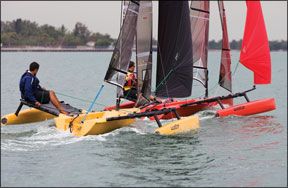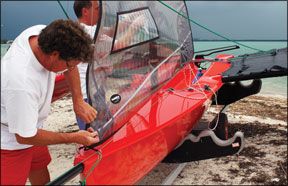The new Weta trimaran is designed in New Zealand, built in China, and imported into the U.S. by Nor Banks Sailing of Duck, N.C.
Photo by Billy Black

When it comes to the pure love of sailing, its hard to beat a small, light efficient boat whose sole mission is to harness the wind rather than provide a home afloat. And now that Hobie and others are moving toward heavy, flexible, roto-molded plastic, and lower performance “beach boats,” its no surprise that a new mini-multihull has come along to fill the niche.
During the few days immediately following the Miami Boat Show in February, Biscayne Bay, Fla., becomes a multihull playground where shallow-draft cats and tris strut their stuff. In a David-and-Goliath replay, the 14-foot-6-inch long Weta trimaran streaked like an agile mouse amidst a herd of elephants. The big cruising cats certainly offer sumptuous accommodations, but they lumbered in the fickle 10- to 12-knot breeze that touched down and lifted off the bays green water. At the same time, the Weta 4.4 scooted off on double-digit reaches, accelerating with each puff, and ghosted through the lulls. If enjoying an active sailing experience on Miamis aquatic frontyard was the plan of the day, the Weta won hands-down.
Conceived in New Zealand by father-and-son team Roger and Chris Kitchen, and designed with collaborative help from a handful of experienced sailors, this elegantly simple and finely built boat is a glowing example of mission accomplished. The company principals, an ex-mathematics teacher and his highly skilled Laser-racing son, bridged both a generation and engineering gap, and came up with the performance boat both had envisioned. The big challenge, however, was in creating a cost-effective boat with the strength-to-weight ratio needed for performance sailing. And a good part of the Wetas challenge was to mate an efficient design concept with the careful use of high-tech and mainstream materials along with exacting composite boatbuilding techniques.
Construction
A carbon-fiber and E-glass tubular framework connects the outer amas to the hull and successfully spreads rig and hull loads. The mast and sprit are also made of carbon fiber, but the light, stiff hull structure, daggerboard, and rudder are built using less-costly E-glass and Divinycell foam. Wetas key to fabrication success stems from the builders aerospace-like attention to detail. Vacuum-bagging and strict resin control results in the elimination of resin puddling and sloppy glasswork in hard-to-get-at areas, and offers excellent weight control. The 220-pound boat is as lean and fat free as a long-distance runner, yet retains the strength and stiffness needed in a high-performance sailboat. These boats are built in China, and they represent a new trend in Asian boatbuilding, an industry once known only for thick, resin-rich laminates and carved teak trailboards.
The deck layout and hardware selection make absolute sense, and show the value of continual input from accomplished small-boat sailors. Not only is there sensible layout of the sheet leads, cleats, and control lines, but all the gear works from either inboard or outboard hiking locations. When you first climb aboard the trimaran, youll find that theres plenty of room for two seated on the comfortable side deck of the main hull, and theres even room for big feet and the mainsheet tail in the full-length cockpit well. Sitting out to windward on the canvas trampoline, the tiller extension and sheet leads make sail trimming and screacher control a snap. Its hard to make a small boat really roomy, but the Wetas wide canvas side deck extension and main hull create plenty of room for a couple and a cooler.
Photo by Ralph Naranjo

SailPlan
The success of this pocket-sized trimaran also stems from its sailplan, a triple threat of main, jib, and easy-handling, furling screacher. The boomless mainsail, made by windsurfer sailmaker Gaastra, incorporates five full tubular battens that control draft and allow the mainsheet to be attached to a well-reinforced clew rather than a conventional boom. Its sculpted foot allows a crew to easily duck under during tacks but still keeps sail area maximized. Gaastra transferred quite a bit of its “go fast” sail shaping into the sailplan, including light tubular batten technology and X-ply and monofilm sail material. The high-tech Gaastra sail package, like the Harken hardware and carbon sprit and mast are all standard, and the result is a package primed for performance.
The upwind sailplan is that of a classic multihull with a big main (75 square feet) and small jib (23 square feet) providing enough drive to make ghosting in light air more than a possibility. Thanks to this efficient sailplan, tight sheeting angle, and a foil-shaped daggerboard, the boat points quite well-more like a one-design dinghy than a multihull. Steer a little wider and the roller furled “screacher” can add a virtual turbo boost. This 60-square-foot gennaker deploys like any roller furler but is trimmed via a single sheet led through both port and starboard leads. As a result, there is much less line to cope with and no sheet tails to drag in the water. To date, the top recorded speed has been 16.5 knots.
The ride is both exhilarating and responsive, sort of like sit-down windsurfing, lots of speed but fewer gymnastics. The helm is fingertip light, and the boats responsiveness takes a little getting used to in order to avoid oversteering. The slight up angle of the amas keeps the windward ama out of the water most of the time, reducing drag. Spray flies, and the boats proximity to the waters surface delivers an enhanced sensation of speed. In a way, it makes sailing more of a contact sport, best suited for warm water and sunny skies. Extending the sailing season means a commitment to good drysuit or wetsuit technology.
Putting the boat away is expedited by the handy beach dolly that comes as a standard component of the new boat. It captures the main hull and locks it in place for quick de-rigging or beach storage. It also eliminates the tendency to scar the hulls by dragging them up and down the beach. Rigging, and its end-of-session reversal, takes less than 20 minutes. This includes assembling the amas and hull, stepping the mast and sprit, and setting the sails. The boats user-friendliness is a tribute to the designers. Whether or not you enjoy multihull sailing, its hard not to give high marks to a well-thought-out sailboat.

































